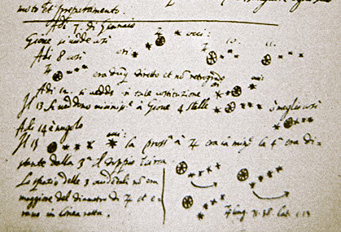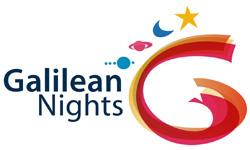The International Year of Astronomy is still in full swing, though many of the signature events have already come and gone. In particular, "100 Hours of Astronomy" was a smash hit. For four days, April 2-5, you could visit 80 professional observatories worldwide via a live, round-the-clock online tour. In those few days more than a million people got telescopic views of the cosmos for the first time.

An entry in Galileo’s notebook, with drawings of Jupiter and its moons.
International Year of Astronomy
In the end, "100HA" was so successful that IYA organizers decided to have an encore — "Galilean Nights" on October 22-24. Once again the world's professional and amateur astronomers will be out in force to encourage as many people as possible to look through a telescope. This time there'll be special focus (ouch!) on the objects that Galileo observed, with the Moon and Jupiter well-positioned in the evening sky.
Would you like to relive the revolutionary telescopic discoveries made 400 years ago? If so, then head for the Galilean Nights website, where you'll find a list of planned events and resources to help you create one of your own if you wish.

Official logo of Galilean Nights.
International Year of Astronomy
For the more ambitious among you, Galilean Nights also features an astrophotography competition that's going on right now! There are two categories, "Earth and Sky" and "Beyond Earth," and the last day to enter is October 27th. So dust off your camera, and give it a try. (New to astrophotography? No problem! We've got lots of advice for getting started.)
 2
2









Comments
David Rodger
October 1, 2009 at 10:43 am
A few weeks ago there was an occasion when all four Galilean moons were "invisible" for a few hours. They were either in front of the planet or in its shadow, I recall. I can't help pondering what Galileo might have done - - or not done - - had he been viewing on a night that like. Would he have come back to Jupiter another time, or might he have concluded it was a pale disc with, perhaps a band or two, and moved on to other celestial sights. I guess one could pose the same mind game over Saturn's rings being on edge when he looked at that planet.
Food for thought!
DAR
You must be logged in to post a comment.
David Rodger
October 1, 2009 at 10:43 am
A few weeks ago there was an occasion when all four Galilean moons were "invisible" for a few hours. They were either in front of the planet or in its shadow, I recall. I can't help pondering what Galileo might have done - - or not done - - had he been viewing on a night that like. Would he have come back to Jupiter another time, or might he have concluded it was a pale disc with, perhaps a band or two, and moved on to other celestial sights. I guess one could pose the same mind game over Saturn's rings being on edge when he looked at that planet.
Food for thought!
DAR
You must be logged in to post a comment.
You must be logged in to post a comment.